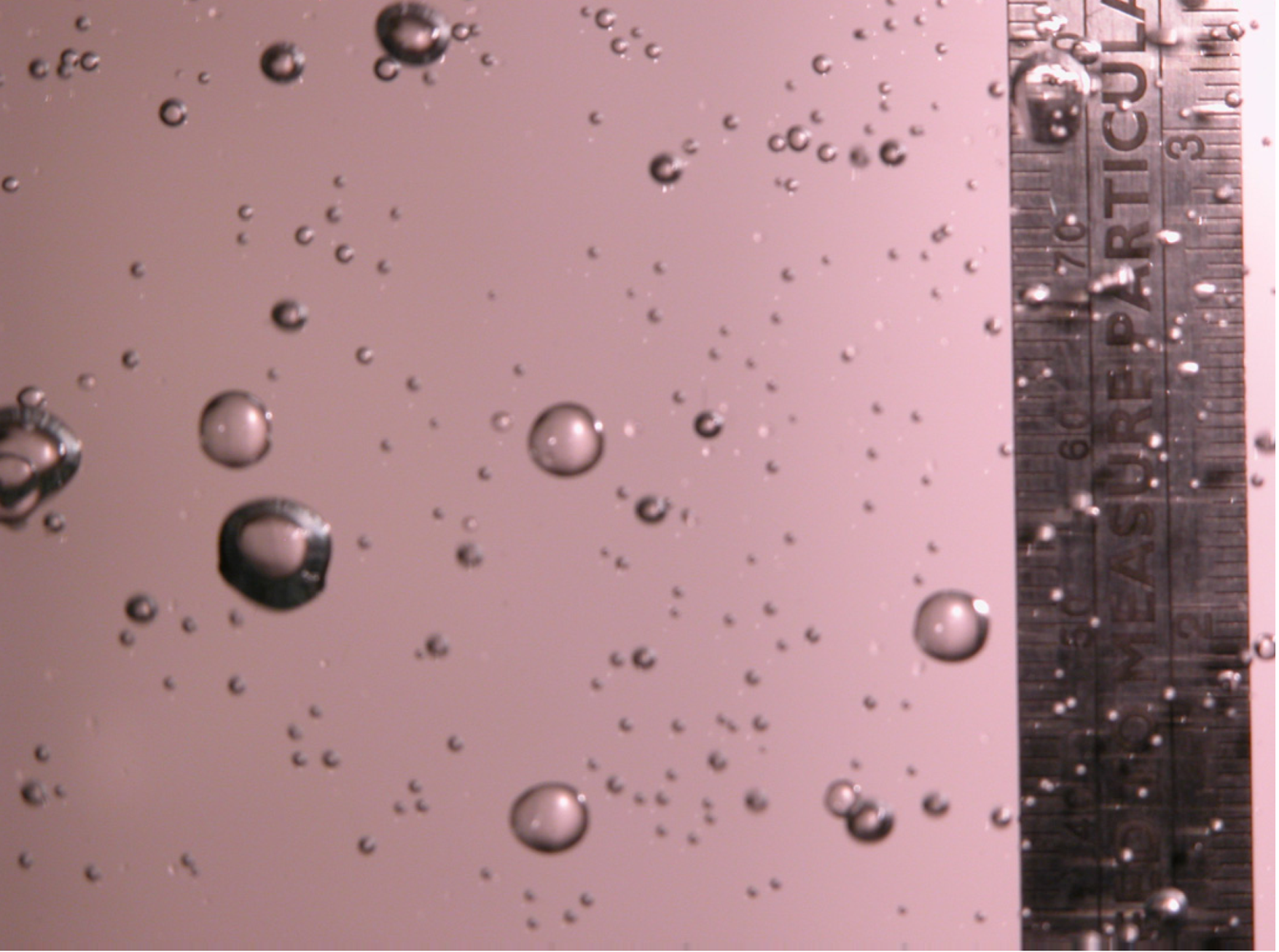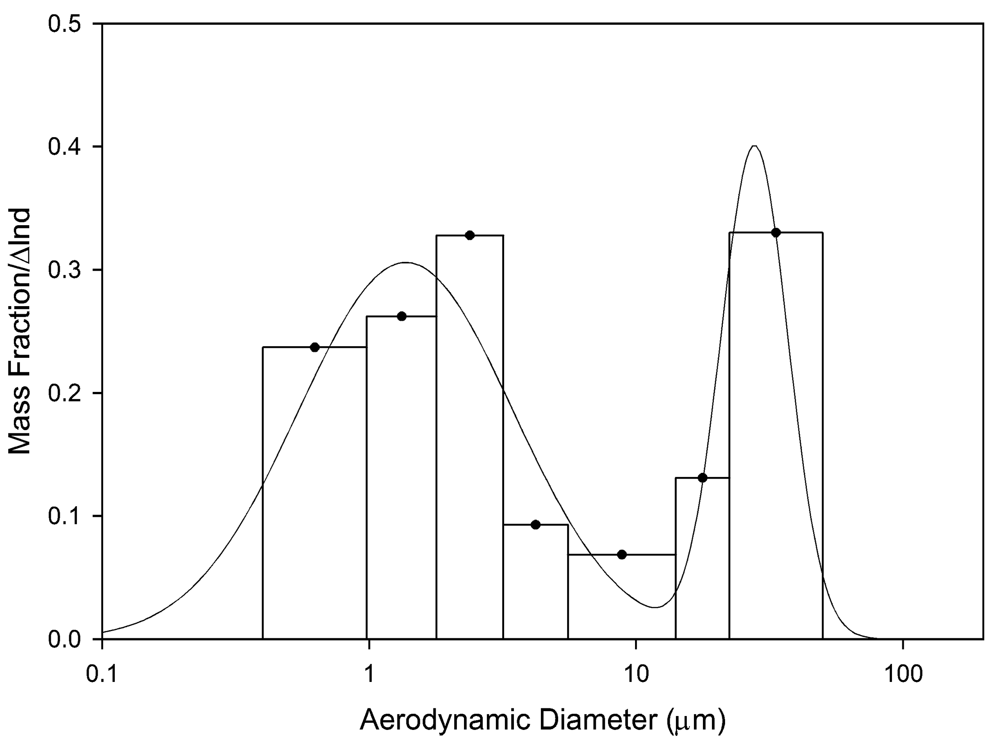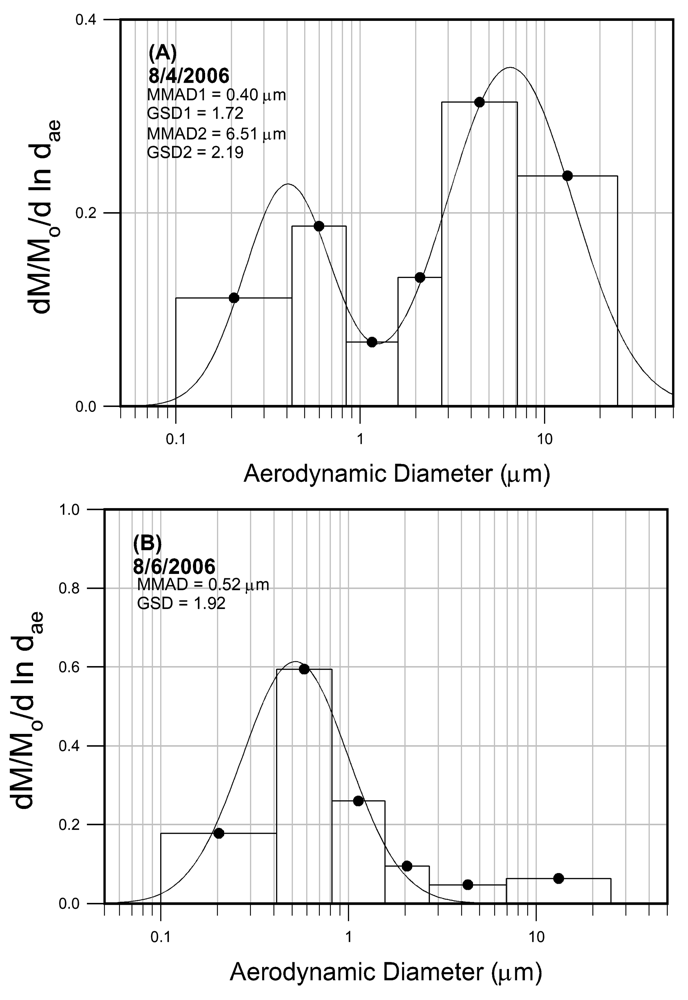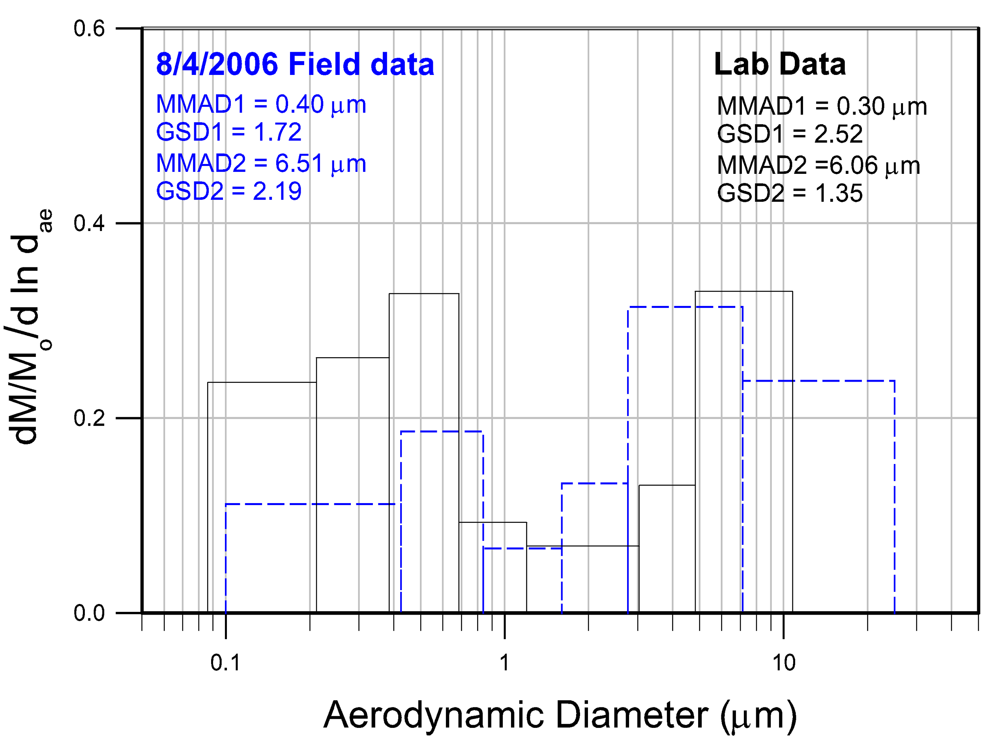Characterization of Aerosols Containing Microcystin
Abstract
:1. Introduction
2. Results and Discussion
2.1. Filter Extraction Efficiency
2.2. Particle Size Distribution and Concentration of Aerosolized Microcystins in the Laboratory
2.3. Field Study
3. Conclusion
4. Materials and Methods
4.1. Aerosol Sampling Equipment
4.2. Analysis of Microcystin
4.3. Aerosolization of Microcystin
4.4. Field Study
Acknowledgements
- Samples Availability: Available from the authors.
References
- Backer, LC; Carmichael, W; Kirkpatrick, B; Williams, C; Irvin, M; Zhou, Y; Johnson, TB; Nierenberg, K; Hill, VR; Kieszak, SM; Cheng, YS. Recreational exposure to microcystins during a Microcystis aeruginosa bloom in a small lake. Marine Drugs. submitted.
- Bernstein, IL; Safferman, RS. Sensitivity of skin and bronchial mucosa to green algae. J Allergy 1966, 38, 166–173. [Google Scholar]
- Blanchard, DC; Syzdek, LD. Concentration of bacteria from bursting bubbles. J Geophys 1972, 77, 5087–5099. [Google Scholar]
- Blanchard, DC; Syzdek, LD. Electrostatic collection of jet and film drops. Limnol Oceano 1975, 20, 762–774. [Google Scholar]
- Blanchard, DC; Woodcock, AH. Bubble formation and modification in the sea and its meterological significance. Tellus 1957, 9, 145–158. [Google Scholar]
- Carmichael, WW. Occurrence of toxic cyanobacteria. In A Status Report on Plantonic Cyanobacteria (Blue-Green Algae) and their Toxins; US Environmental Protection Agency, 1992; pp. 15–26. [Google Scholar]
- Cheng, YS; McDonald, J; Kracko, D; Irvin, CM; Zhou, Y; Pierce, RH; Bourdelais, A; Naar, J; Baden, DG. Concentrations and particle size of airborne toxic algae (brevetoxin) derived from ocean red tide events. Environ Sci Technol 2005a, 39, 3443–3449. [Google Scholar]
- Cheng, YS; Villareal, TA; Zhou, Y; Gao, J; Pierce, RH; Wetzel, D; Naar, J; Baden, DG. Characterization of red tide aerosol on the Texas coast. Harmful Algae 2005b, 4, 87–94. [Google Scholar]
- Cheng, YS; Zhou, Y; Irvin, CM; Pierce, RH; Naar, J; Backer, LC; Fleming, LE; Kirkpatrick, B; Baden, DG. Characterization of marine aerosol for assessment of human exposure to brevetoxins. Environ. Health Perspectives. Environ Health Perspectives 2005c, 113, 638–643. [Google Scholar]
- Chorus, I; Bartram, J. E & FN Sponsored on behalf of the World Health Organization, Toxic cyanobacteria in water A guide to their public health consequences, monitoring, and management; 1999. [Google Scholar]
- Chorus, I; Falconer, IR; Salas, HJ; Bartram, J. Health risks caused by freshwater cyanobacteria in recreational waters. J Toxicol Environ Health (B) 2000, 3, 323–347. [Google Scholar]
- Chu, FS; Huang, X; Wei, RD. Enzyme-linked immunosorbent assay for microcystins in blue-green algal blooms. J Assoc Off Anal Chem 1990, 73(3), 451–456. [Google Scholar]
- Codd, GA; Bell, SG; Kaya, K; Ward, CJ; Beattie, KA; Metcalf, JS. Cyanobacterial toxins, exposure routes and human health. Eur J Phycol 1999, 34, 405–416. [Google Scholar]
- Conti, AL; Guerrero, JM; Regueira, JM. Levels of microcystins in two Argentinean reservoirs used for water supply and recreation: differences in the implementation of safe levels. Environ Toxicol 2005, 20, 263–269. [Google Scholar]
- Fischer, WJ; Garthwaite, I; Miles, CO; Ross, KM; Aggen, JB; Chamberlin, AR; Towers, NR; Dietrich, DR. Congener-independent immunoassay for microcystins and nodularins. Environ Sci Technol 2001, 35, 4849–4856. [Google Scholar]
- Hilborn, ED; Carmichael, WW; Yuan, M; Azevedo, SMFO. A simple colorimetric method to detect biological evidence of human exposure to microcystins. Toxicon 2005, 46, 218–221. [Google Scholar]
- Hinds, WC. Aerosol Technology; John Wiley & Sons: New York, 1999; pp. 294–302. [Google Scholar]
- Maizels, M; Budde, WL. A LC/MS method for determination of cyanobacteria toxins in water. Anal Chem 2004, 76, 1342–1351. [Google Scholar]
- Mark, D; Vincent, JH. A new personal sampler for airborne total dust in workplaces. Ann Occup Hyg 1986, 30, 89. [Google Scholar]
- McDermott, CM; Feola, R; Plude, J. Detection of cyanobacterial toxins (microcystins) in waters of northeastern Wisconsin by a new immunoassay technique. Toxicon 1995, 33(11), 1433–1442. [Google Scholar]
- McGovern, JP; McElhenney, TR; Brown, M. Airborne algae and their allergenicity: Part I air sampling an delineation of the problem. Ann Allergy 1965, 23, 47–50. [Google Scholar]
- Metcalf, JS; Bell, SG; Codd, GA. Colorimetric immuno-protein phosphatase inhibition assay for specific detection of microcystins and nodularins of cyanobacteria. Appl Environ Microbiol 2001, 67, 904–909. [Google Scholar]
- Mittal, A; Agarwal, MK; Shivpuri, DN. Studies on allergenic algae of Delhi area: Botanical aspects. Ann Allergy 1979, 42, 248–252. [Google Scholar]
- Monahan, EC; Zietlow, CR. Laboratory comparisons of fresh-water and salt-water whitecaps. J Geophys Res 1969, 74, 6961–6966. [Google Scholar]
- Oberholster, PJ; Botha, A-M; Grobbelaar, JU. Microcystis aeruginosa: source of toxic microcystins in drinking water. African J Biotech 2004, 3, 159–168. [Google Scholar]
- Phalen, RF; Hinds, WC; John, W; Lioy, PJ; Lippmann, M; McCawley, MA; Raabe, OG; Soderholm, SC; Stuart, BO. Rationale and recommendations for particle size-selective sampling in the workplace. Appl Ind Hyg 1986, 1, 3–12. [Google Scholar]
- Philipp, R; Bates, AJ. Health-risks assessment of dinghy sailing in Avon and exposure to cyanobacteria (Blue-green algae). J Inst Water Environ Manage 1992, 6, 613–617. [Google Scholar]
- Pierce, RH; Henry, M; Boggess, S; Rule, A. Monahan, EC, Van Patten, MA, Eds.; Marine toxins in bubble-generated aerosols. In Climate and Health Implications of Bubble-Mediated Sea-Air Exchange; Connecticut Sea Grant College Program: Groton CT, 1989; pp. 27–42. [Google Scholar]
- Pierce, RH; Henry, MS; Blum, PC; Lyons, J; Cheng, YS; Yazzie, D; Zhou, Y. Brevetoxin concentrations in marine aerosol: human exposure levels during a Karenia brevis harmful algal bloom. Bull Environ Contam 2002. [Google Scholar]
- Pilotto, LS; Douglas, RM; Burch, MD; Cameron, S; Beers, M; Rouch, GJ; Robinson, P; Kirk, M; Cowie, CT; Hardiman, S; Moore, C; Attewell, RG. Health effects of exposure to cyanobacteria (blue-green algae) during recreational water-related activities. Aust NZ J Public Health 1997, 21, 562–566. [Google Scholar]
- Schlichting, HE. Ejection of microalgae into the air via bursting bubbles. J Allergy Clinical Immunol 1974, 53, 185–188. [Google Scholar]
- Stewart, I; Webb, PM; Schluter, PJ; Fleming, LE; Burns, JW, Jr; Gantat, M; Backer, LC; Shaw, GR. Epidemiology of recreational exposure to freshwater cyanobacteria- an international prospective cohort study. BMC Public Health 2006, 6, 93–104. [Google Scholar]
- Turner, PC; Gammie, AJ; Hollinrake, K; Codd, GA. Pneumonia associated with contact with cyanobacteria. Brit Med J 1990, 300, 1440–1441. [Google Scholar]
- WHO, Guidelines for drinking-water quality, 2 ed; In Addendum to Volume 2 Health criteria and other supporting informationGeneva, World Health Organization: Geneva, 1998.
- Welker, M; Khan, S; Haque, MM. Islam S, Khan NH, Chorus I, Fastner J. Microcystins (cyanobacterial toxins) in surface waters of rural Bangladesh: pilot study. J Water Health 2005, 3, 325–337. [Google Scholar]
- Woolf, DK; Bowyer, PA; Monahan, EC. Discriminating between the film drops and jet drops produced by a simulated white cap. J Geophys Res 1987, 92, 5142–5150. [Google Scholar]







| Spike mass (ng) | Remaining vol. (μL) | Extraction mass* (ng) | Extraction efficiency* (%) |
|---|---|---|---|
| 5 | 800 | 5.53 ± 0.76 | 110.6 ± 15.2 |
| 2.5 | 800 | 2.04 ± 0.18 | 81.6 ± 7.4 |
| 1 | 800 | 0.83 ± 0.13 | 82.6 ± 12.7 |
| 0.5 | 800 | 0.47 ± 0.10 | 93.1 ± 19.1 |
| 0.25 | 800 | 0.22 ± 0.08 | 86.9 ± 30.5 |
| 0.1 | 800 | 0.08 ± 0.02 | 82.8 ± 19.8 |
| Mean | 89.7 | ||
| SD | 11.1 | ||
| Date | Temperature (C) | Humidity (%) | Average Wind Speed (m/s) |
|---|---|---|---|
| 8/4/2006 | 31.1 ± 1.4 | 38.4 ± 8.4 | 3.4± 0.9 |
| 8/5/2006 | 29.7 ± 2.7 | 46.3 ± 8.0 | 1.5± 1.1 |
| 8/6/2006 | 26. 0± 2.3 | 71.7 ± 10.0 | 3.2± 1.6 |
| Date | Microcystin Concentration (ng/m3) | Sample Number |
|---|---|---|
| 8/4/2006 | 0.08 ± 0.09 | 10 |
| 8/5/2006 | 0.07 ± 0.14 | 10 |
| 8/6/2006 | 0.0 ± 0.0 | 4 |
Share and Cite
Cheng, Y.S.; Yue, Z.; Irvin, C.M.; Kirkpatrick, B.; Backer, L.C. Characterization of Aerosols Containing Microcystin. Mar. Drugs 2007, 5, 136-150. https://doi.org/10.3390/md504136
Cheng YS, Yue Z, Irvin CM, Kirkpatrick B, Backer LC. Characterization of Aerosols Containing Microcystin. Marine Drugs. 2007; 5(4):136-150. https://doi.org/10.3390/md504136
Chicago/Turabian StyleCheng, Yung Sung, Zhou Yue, C. Mitch Irvin, Barbara Kirkpatrick, and Lorraine C. Backer. 2007. "Characterization of Aerosols Containing Microcystin" Marine Drugs 5, no. 4: 136-150. https://doi.org/10.3390/md504136




